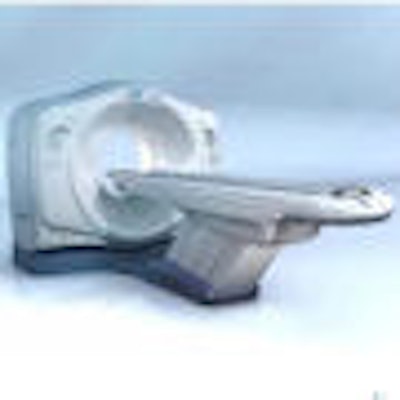
GE Healthcare is announcing today the commercial launch of LightSpeed CT750 HD, a new CT scanner that the Chalfont St. Giles, U.K.-based company believes breaks new ground in high-resolution imaging. GE believes the 64-slice system offers an alternative to the CT slice wars that the company thinks have done little to improve everyday clinical image quality.
The CT750 HD scanner incorporates a battery of technical innovations aimed at boosting image quality from top to bottom, particularly in the body imaging space. GE just received 510(k) approval for the product, which will be discussed at Stanford University's International Symposium on Multidetector-Row CT, taking place this week in Las Vegas.
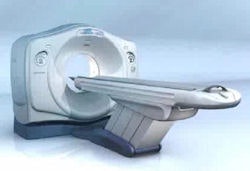
On the electronics side, the scanner represents a major investment GE has made in dual-energy CT, a promising technique that could help clinicians using CT better delineate soft tissues, eliminate artifacts, and potentially improve CT's ability to diagnose disease. On the detector side, the first new scintillator material in a generation improves resolution by a third while reducing radiation dose, according to GE.
Taken together, these features promise to improve spatial resolution by one-third compared to current-generation 64-slice scanners, while providing dual-energy scans acquired on a single x-ray tube, GE said.
According to GE, the key features of the CT750 HD scanner include the following:
- The Gemstone detector, which leverages the superior light-handling properties of garnets; in imaging applications, the detector supports material decomposition for the entire 50-cm field-of-view
- High-definition dual-energy signal views, enabling the differentiation of scanned tissues with different spectral properties, while eliminating common image artifacts
- High-definition Performix x-ray tube, which matches focal spot size to the imaging application
- High-definition generator capable of fast-switching dual-energy CT
"It looks very similar to a traditional LightSpeed (CT scanner), but under the hood, it's a totally different scanner," said Dom Smith, GE's general manager of CT marketing.
GE developed the components specifically for the new system, which wouldn't perform as well with off-the-shelf alternatives, he said. For example, the garnet-based scintillator material in the detectors that replaces the gadolinium oxysulfide (GOS) scintillators used industry-wide produces intrinsically sharper and brighter images owing to the superior optical properties of the gemstone, according to Eric Stahre, GE's leader of premium CT products.
Only diamonds surpass garnet's light properties, Stahre said, a reason why garnets are already used in critical applications such as laser eye surgery.
The modified crystalline structure of the gemstone-based scintillator material, created by combining garnet with rare-earth phosphor in a proprietary process that replaces portions of the molecular lattice, enhances both the efficiency and durability of the final product, Stahre said.
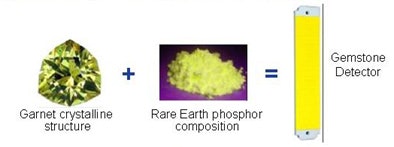
Garnet-based scintillators transfer light more efficiently to the detector diode and speed processing times by shortening the afterglow period significantly compared to GOS. The Gemstone detector, 100 times faster than GOS-based components, was developed at GE's global research center, garnering "seven or eight" patents since the work began, he said.
"A fundamental GE core competency has been in the material sciences area," Stahre said. "These guys have been toiling for years at this stuff. They work across all our businesses and they're world-class."
Superior optical properties are what enable CT750 HD's high-definition generator to acquire approximately 2,250 images per second, electronically switching tube energies from 40 kVp to 120 kVp to acquire dual-energy images with a single x-ray tube during operation, Stahre explained. Dual-energy imaging using a single x-ray source is the system's other key capability.
"Today, most scanners acquire about 888 to 984 pictures per rotation, and this hasn't changed in eons," Smith told AuntMinnie.com. "This (system) takes two-and-a-half times that many -- and the more pictures you take, the better raw data you get."
Pulsing rapidly from low (40 kVp) to high (120 kVp) and back again, each exposure takes about 0.5 msec -- about a quarter of the time it takes to blink an eye. The switching is electronically controlled, and because each energy burst is so short, image quality is improved while dose is reduced, Smith said.
The concept for the new scanner arose from marketing research conducted with more than 400 physicians. Survey respondents said they were looking for ways to get higher resolution and better diagnostic confidence in body imaging without increasing dose. Respondents needed better ways to examine potential cancers and to look inside stents to better assess patency, Smith said. "Fundamentally, we wanted to see more, know more, with less dose," he said.
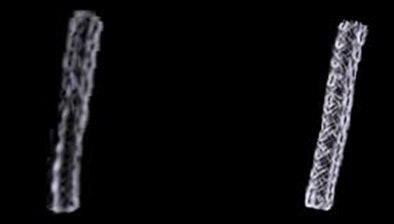
Higher slice counts and dual x-ray tubes do a good job of freezing motion and increasing coverage area, respectively, but the images aren't much sharper than the 16-slice data that's been available for a decade and, therefore, don't help much with noncardiac applications, Smith said. "That brought us into the direction of image quality and into the gemstone area," he said.
During a live demonstration that included scanning acorn squashes and watermelons for the benefit of a reporter, the staff compared images from CT750 HD side-by-side with the older GE model, revealing finer resolution of internal structures in the former.
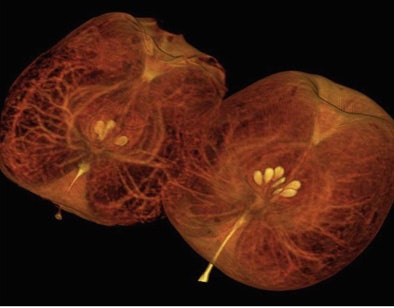
Then again, produce doesn't move around much. A beating heart does, and because the CT750 HD retains LightSpeed VCT's 64-slice configuration, its motion-freezing capabilities are essentially unchanged from those of the current 64-slice LightSpeed scanner, according to GE.
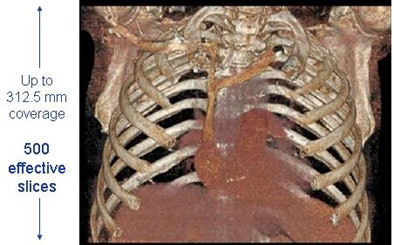
Still, for the "98% of imaging applications" that are noncardiac, qualities other than speed and coverage are paramount, and CT750 HD tackles image-quality issues that had not been addressed previously, Smith said. Documents provided to AuntMinnie.com showed gains in both spatial resolution and dose.
According to claims GE said were included in the system's 510(k) application, CT750 HD delivers spatial resolution of 230 microns at the 2-mm scan length, compared to approximately 300 microns for current-production 64-slice scanners. That translates to as much as 33% better resolution in body imaging for the new machine, up to 47% improved resolution in heart imaging, and up to 40% better low-contrast detectability -- all at up to 50% less dose in body imaging.
Modulation of the tube current (mAs) is unaffected by dual-energy (kVp) scanning, offering a straightforward method of reducing the dose further, Stahre said.
The potential of dual-energy imaging with rapidly pulsing high and low kVp, previously limited to experiments in dual-source CT scanners, remains underexplored. But it could potentially lead to better diagnostic capabilities with fewer invasive interventions, Smith said.
"Until now, CT has generally been only a single energy, and you modulated the mAs to get the signal," he said. "You never crossed the boundary into the functional imaging space."
In the hands of researchers, dual-energy analysis of images could potentially help distinguish cysts from cancers and possibly even malignant from nonmalignant lesions in the lungs, colon, solid organs, and blood vessels.
"We have actually subtracted out iodine and water in soft tissues. If you measure the energy, you can actually discern where cysts and cancers are," Smith said.
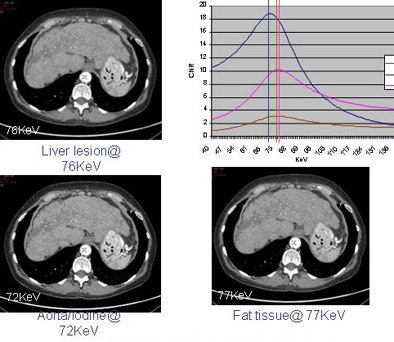
The dual-energy-signal views enable the user to dial into an interpolation of the precise energy that shows the pathology best, or, for example, eliminates calcium and its blooming artifacts, which can improve visualization of noncalcified regions.
In orthopedic applications, modification of tube energies can eliminate beam-hardening artifacts, though research in dual-energy CT imaging is sparse. Smith said he sees great potential in many other areas.
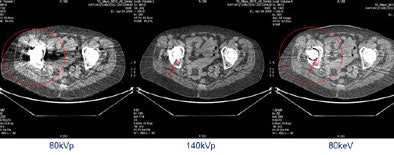
The interpolation process, performed by the scanner's software, can estimate 101 energy levels that fall between high and low kVp levels pulsed during scanning, Stahre said. The interpolation function is precise, he said, because it is based on known attenuation curves for various materials. Therefore, by comparing the same point on two curves, many materials such as water and iodine can be distinguished, potentially enabling the differentiation of soft tissues. For example, early research has shown that a liver cyst that absorbs water can be distinguished from a tumor, which absorbs iodine.
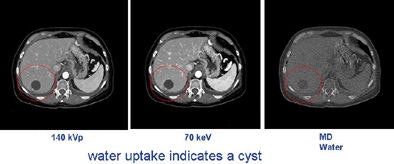
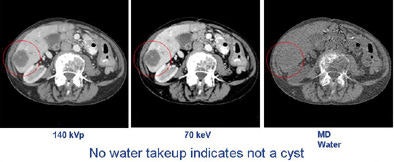
Clinical aspirations
One of the first users of CT750 will be Dr. Dennis Foley, chief of digital imaging and professor of radiology at Froedtert & Medical College Clinics in Milwaukee, who was scheduled to take delivery of the first CT750 HD last week. Foley tested a prototype version last fall and said he was hopeful that the technology could address several shortcomings in current CT practice.
Because the new scanner will acquire more than 2,000 samples per rotation, it will yield "intrinsically better data" compared to older machines, he said. "The expectation is that we will improve spatial resolution by about 30% -- this is based on engineering tests rather than demonstrated clinically yet," Foley said.
Cardiac image quality is expected to improve as well, while dose is expected to drop with the aid of GE's ASIR (adaptive statistical iterative reconstruction) software, he said. The ability to perform dual-energy scans with a single x-ray tube may also benefit heart imaging, he said, and higher contrast sensitivity should permit reductions in contrast dose.
Prospectively gated ultralow-dose CT angiography with step-and-shoot imaging is not expected to be available until fall of this year.
"The advantage of a single tube is that if you're able to very rapidly separate beam energies, you get identical projection angles in two different beam energies," Foley said. "That should allow us to utilize dual-energy for rapidly moving vessels like the coronary arteries."
Removing calcium from arties through the use of dual-energy scanning is very promising, Foley said, because assessing the degree of stenosis is difficult with current scanners due to calcium blooming artifact. Eliminating the blooming by eliminating the calcium would in turn improve soft-tissue delineation, but whether this capability will be enough to distinguish different soft-plaque compositions remains to be seen, he said. In any case, the scanner will offer potential benefits beyond cardiac imaging, he said.
"You've got these small pancreatic cystic lesions … can you better define those? You've got the indeterminate renal lesion, is it a cyst or a solid tumor? What about detecting smaller tumors in screening for liver disease?" Foley said. In the lungs, there is potential for better assessing lung nodules in serial studies.
Carotid arteries and especially abdominal visceral arteries are as difficult to assess as coronaries due to calcium, Foley said. "Currently, we use curved planar reformations to see those better, but removing the calcium would be the most effective (way)," Foley said. "In the leg arteries, one of the issues with CT angiography is that … diabetic patients have a lot of calcium in their small vessels. You take the calcium out, you've got the solution."
From his perspective, more important than new applications is "doing what we currently do better," Foley said.
GE has not announced a list price for CT750 HD, but a spokesman said it will likely be in the range of other manufacturers' premium CT offerings. Commercial shipments beyond a few luminary sites are expected to begin over the next several months.
By Eric Barnes
AuntMinnie.com staff writer
May 13, 2008
Related Reading
First 320-slice coronary CTA study shows high image quality, April 7, 2008
Prospective gating drops cardiac CT radiation dose, March 10, 2008
Aquilion One 320-slice CT scanner spearheads Toshiba RSNA launches, November 26, 2007
GE RSNA highlights include new CT, MRI, molecular technologies, November 26, 2007
Radiation dose slashed in 64-slice coronary CTA, February 15, 2007
Copyright © 2008 AuntMinnie.com




















